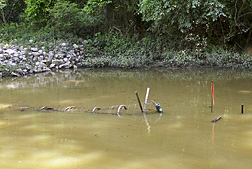This page has been archived and is being provided for reference purposes only. The page is no longer being updated, and therefore, links on the page may be invalid.
| Read the magazine story to find out more. |
|
|
|
|
Using Local Lakes to Safeguard Regional Water Quality
By Ann Perry
September 26, 2014
Isolated lakes in the Mississippi Delta can be transformed into farmer-friendly landscape features that trap agricultural pollutants, according to research at the U.S. Department of Agriculture (USDA). These findings by Agricultural Research Service (ARS) ecologist Richard Lizotte and his colleagues can help producers control the impacts of field runoff on downstream water bodies as far as the Gulf of Mexico. ARS is USDA's chief intramural scientific agency.
Lizotte, who works at the ARS Water Quality and Ecology Research Unit in Oxford, Mississippi, led a series of studies that evaluated how effectively an experimental wetland along Mississippi's Coldwater River trapped common crop pesticides. The study watershed was developed in a small stretch of the river that had been cut off from the main channel. The resulting pool had two distinct sections: One was as deep as a small lake, and the other was a shallow wetland surrounded by natural vegetation.
The team installed small dams called weirs at either end of the wetland. Then they added three pesticides to the wetland at the upstream weir at rates that would simulate typical runoff rates from a 40-acre field.
After the researchers added the pesticide mix to the water, it only took 24 hours for pesticide concentrations near the upstream weir to drop almost 65 percent, while at the downstream weir, only trace amounts of the pesticide were detected. Pesticide concentrations became undetectable at the upstream weir 21 days later.
Lizotte also assessed how well the experimental wetland reduced concentrations of pesticides, nutrients, and sediment from a "catastrophic" runoff event that could result from sudden and severe storms shortly after fertilizers and/or pesticides are applied. He noted that sediment, phosphorus, nitrogen, and pesticide concentrations peaked within three hours after the event as far as 325 yards below the upstream weir.
But within 48 hours, loads of the sediment, nutrients, and pesticides had been reduced by as much as 98 percent. Twenty-eight days later, levels of all the pollutants had returned to—and sometimes even dropped below—pre-event levels.
Lizotte believes his findings show that these types of wetlands could become a very effective and efficient tool for reducing field runoff contaminants.
Results from his research have been published in River Research and Applications, Science of the Total Environment, and Ecohydrology.
Read more about this work in the September 2014 issue of Agricultural Research magazine.

